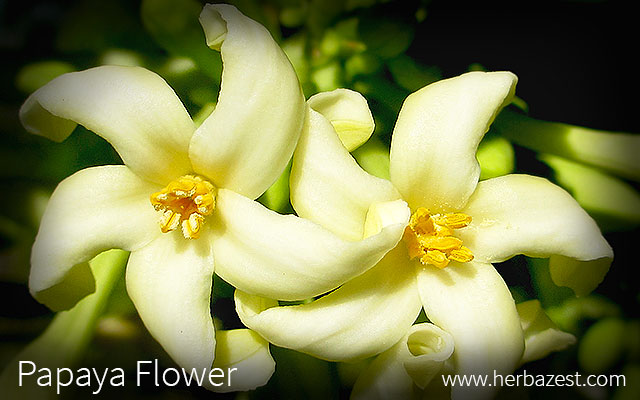The papaya flowers are tubular, trumpet-shaped blossoms emerging from the axils of the papaya leaf. Growing to between one and two inches (2.5 - 5 cm) long, they are waxy and sweetly perfumed. Their color ranges from a pale ivory to golden yellow.
Because of their bright color, papaya tree flowers are very often used as colorful food garnishes or festive decorations. In Southeast Asia, flower arrangements are sold throughout local food markets, and are either candied, or boiled and eaten as a vegetable. Meanwhile, a warm papaya flower decoction is said to cure bronchitis, congestion, and respiratory illness when taken orally.
Papaya Flower Characteristics
The papaya flower is easily the most complex part of any papaya tree. It is characterized not only by its shape and appearance, but also by the presence or absence of stamens, pistils, and ovaries.
The female papaya flower contains a reproductive part known as a pistil. It is a long canal containing a five-lobed stigma and egg-shaped ovary. The ovary does not exist in a male papaya flower, which is a non-pistillate blossom with 10 functional stamens - thin, wispy plant parts that carry grains of pollen.
A PAPAYA FLOWER CAN BE MALE, FEMALE, OR HERMAPHRODITIC. SINCE MALE PAPAYA FLOWERS CANNOT BEAR FRUITS, MOST GARDENING DISCUSSIONS ARE FOCUSED ON SEX IDENTIFICATION FOR GROWING.
The third type of papaya flower is unique and multifaceted. Hermaphroditic by nature, it contains both male and female parts and it is capable of self-pollination. These 'perfect flowers', as they have come to be known, develop between 5 - 10 stamens and contain ovaries of varying shapes, from smooth and bulbous to oblong, stretched, or with sporadic folds and ridges.
Although the above mentioned types are the most common, it is also important to note that under certain climatic and environmental conditions, the papaya flower may experience sex changes. It have been recorded that some male papaya flowers have become hermaphroditic in extremely warm weather.
Importance of the Papaya Flower
Ensuring healthy reproduction of the entire plant is one of the reasons why papaya flowers are so important. While male papaya flowers cannot bear fruit, their pollen is transferred by wind, by insects, or by hand in order to fertilize the female ovule.
From the ovaries of a successfully-pollinated papaya flower spring forth the fleshy tropical fruit, much treasured on the commercial market. These fruits contain viable papaya seeds, which are later used to grow new trees.
unpollinated papaya flowers have been known to self-abort, destroying their own unfertilized fruits.
To further complicate the issue of flower type and reproduction, the sex of a papaya flower cannot be determined until nearly five to six months post-planting. For this reason, self-reproducing hermaphroditic plants are highly sought after for home gardening. To achieve bisexual plants and higher crop yields, it is not uncommon for commercial farmers to plant three or five papaya seeds per mound, removing unwanted plants along the way.
Although there is no real difference in the taste or quality of fruits grown from different types of papaya flowers, they often yield fruits of varying shapes: the female papaya flower usually produces round fruits, while hermaphrodite flowers develop pear-shaped or elongated fruits. Their respective demands are determined by commerce and nation-specific preferences.
Over the years, a number of creative food and medicinal preparations have paid homage to the unsung Carica papaya flower. More than just a colorful plant ornament, the papaya flower is one of the most economically-significant parts of the papaya plant, responsible for fruit health and plant reproduction.
Sources
- Breeding Plantation Tree Crops: Tropical Species, pp. 128 - 134
- National Tropical Botanical Garden, Meet the Plants, Carica papaya
- Purdue University, A guide to flowering and why plants fail to bloom
- University of Hawaii, Why some papaya plants fail to fruit | General Crop Information
- World Agroforestry Centre, Carica papaya




